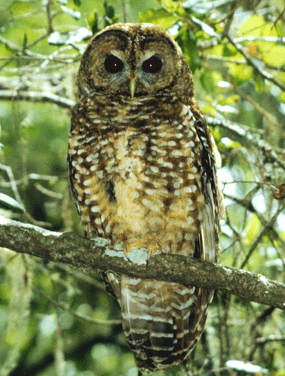
NPS Vital Indicators of Forest Health: The Northern Spotted Owl (Strix occidentalis caurina) graces three National Park lands in Marin County, California. Muir Woods National Monument, Point Reyes National Seashore and Golden Gate National Recreation Area all provide sanctuary for this elusive hunter. The owl is one of the main indicators of the health of these parks. If the owl thrives then the forests of the parks are thriving.
Environment: Northern Spotted Owls range from Marin County in central California northwards to southern British Columbia. They live in both the Coastal and the Cascade Mountain Ranges. The owls usually require large trees for nesting and multi-layered canopies of vegetation for hunting. At the northern end of their range the owls prefer old-growth forests. However, in Marin County they find suitable conditions in most evergreen forests in the area. Spotted Owls usually mate for life. Pairs generally reside in the same location together for their entire lives. Pairs roost together beginning in February to early March. They begin calling to each other at dusk before foraging and at dawn when they return to roost. Spotted Owls typically raise one brood of 1 – 2 chicks each season. Nest initiation and egg-laying occurs during late March to early April in Marin County. Chicks hatch in late April to early May. Owlets leave the nest (fledge) when they are 34 – 36 days old in late May to mid-June. Young can climb and glide into neighboring trees within a few days of leaving the nest. It is also normal for young owls to be on the ground while they learn to fly. Both parents are usually nearby and continue to feed and care for the owlets until they can capture prey on their own. Keep your distance, do not pick up an owl and keep pets away from the grounded owls. The young owls usually achieve this independence in late September.
Decline: The Northern Spotted Owl has been the focus of political controversy surrounding its association with high value commercial timber. The Northern Spotted Owl population has declined as old-growth forests in the Pacific Northwest started to disappear over the past several decades. This decline resulted in the 1990 designation of the Northern Spotted Owl as a threatened species under the federal Endangered Species Act.
Prognosis: In order to keep abreast of the health of the ecosystems in its care, the National Park Service (NPS) started a Spotted Owl Monitoring project in 1997. To estimate the health of the population, the NPS uses long-term monitoring of spotted owl territories to determine the changes in occupancy of sites between years and the number of young produced each year. The National Park sites within Marin County appear to provide much of what the Northern Spotted Owl needs to survive. The owls appear to be prospering in the evergreen forests found in the mild coastal California climate. The study will continue to investigate whether the Spotted Owls and the parks are thriving over the long term.
Learn more about viewing owls without disturbing them. |
Last updated: February 28, 2015
